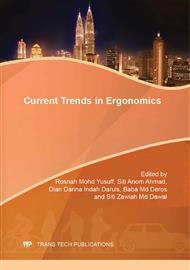[1]
C.C. Chang, S. Hsiang, P.G. Dempsey, and R.W. Mcgrorry, A computerized video coding system for biomechanical analysis of lifting task, Int. J. of Industrial Ergonomics 32 (2003) 239-250.
DOI: 10.1016/s0169-8141(03)00065-9
Google Scholar
[2]
K. Veerapen, R.D. Wigley and H. Valkenburg, Musculoskeletal pain in Malaysia: A COPCORD Survey, The Journal of Rheumatology (2007) 207-213.
Google Scholar
[3]
B. Widanarko, S. Legg, M. Stevenson, J. Devereux, A. Eng, A. Mannetje, S. Cheng, N. Pearce, Applied Ergonomics 43 (2012) 727-737.
DOI: 10.1016/j.apergo.2011.11.004
Google Scholar
[4]
FG. Benavides, Ill Health, Social protection, labour relations, and sickness absence, Occup Environ Med 63 (2006) 221–229.
DOI: 10.1136/oem.2005.025817
Google Scholar
[5]
Bureau of Labor Statistics (2010), information on www. bls. gov.
Google Scholar
[6]
Social Security Organization of Malaysia (SOCSO) Annual Report, (2010).
Google Scholar
[7]
S.P. wu, Maximum acceptable weight for asymmetric lifting of Chinese females, Applied Ergonomics 34 (2003) 215-224.
DOI: 10.1016/s0003-6870(03)00010-3
Google Scholar
[8]
S.M. Alavinia, DucoMolenaar and A. Burdorf, Productivity loss in the workforce: Association with Health, Work Demands, and Individual Characteristics, American J. of Ind. Med. (2008) 1-8.
DOI: 10.1002/ajim.20648
Google Scholar
[9]
A.S. Jackson, G. Borg, J.J. Zhang, K.R. Luaghery, and J. Chen, Role of physical work capacity and load mass on psychophysical lift ratings, Int. J. of Ind. Ergonomics 20 (1997) 181-190.
DOI: 10.1016/s0169-8141(96)00054-6
Google Scholar
[10]
S.P. Wu, Psychophysical determined symmetric and asymmetric lifting capacity of Chinese males for one hour's work shift, Int. J. of Ind. Ergonomics 25 (2000) 675-682.
DOI: 10.1016/s0169-8141(99)00055-4
Google Scholar
[11]
I. Halim, A.R. Omar, A.M. Saman and I. Othman, Assessment of fatigue associated with prolonged standing in the workplace, Safety Health Work 3 (2012), 31-42.
DOI: 10.5491/shaw.2012.3.1.31
Google Scholar
[12]
B. Freriks and H. Hermens, European recommendation for surface electromyography, result of SENIAM Project, " Roessignh Research and Development, The Netherlands (2000).
Google Scholar
[13]
A. Mital, and H.F. Fard, Psychophysical and physiological response to lifting symmetrical and asymmetrical loads, Ergonomics 29 (1986) 1263-1272.
DOI: 10.1080/00140138608967239
Google Scholar
[14]
J. Yoon, A. Shiekhzadeh and M. Nordin, The effect of load weight vs. pace on muscle recruitment during lifting, Applied Ergonomics 43 (2012) 1044-1050.
DOI: 10.1016/j.apergo.2012.03.004
Google Scholar
[15]
N. Singh, R.M. Belokar and R.S. Walia, Physiological evaluation of manual lifting task on Indian male workers, Int. J. of Eng. and Adv. Tech. Vol. 2 Iss. (2012) 8-16.
Google Scholar


